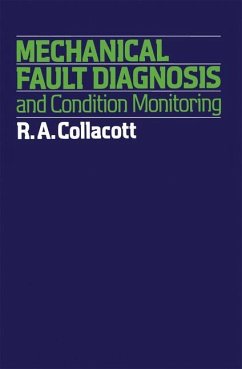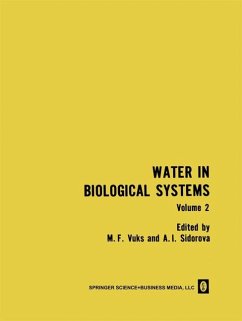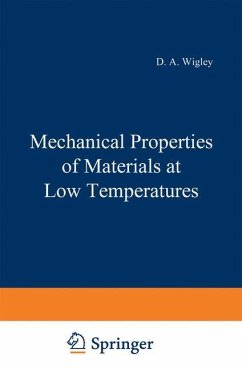R. Collacott
Mechanical Fault Diagnosis and condition monitoring
R. Collacott
Mechanical Fault Diagnosis and condition monitoring
- Broschiertes Buch
- Merkliste
- Auf die Merkliste
- Bewerten Bewerten
- Teilen
- Produkt teilen
- Produkterinnerung
- Produkterinnerung
Although the most sophisticated fault diagnosis and condition monitoring systems have their origin in the aerospace and nuclear energy industries, their use is by no means restricted to such areas of 'high technology'. Modern machinery in most industrial plants is now so complex and expensive that mechanics find it increas ingly difficult to detect failure by, for instance, recognising changes in sound 'signatures', and few plants can afford the luxury of regular 'stripping down'. Increasingly, therefore, eady-warning devices are being employed in an effort to prevent catastrophic breakdown.…mehr
Andere Kunden interessierten sich auch für
![Low-Pressure Synthetic Diamond Low-Pressure Synthetic Diamond]() Low-Pressure Synthetic Diamond75,99 €
Low-Pressure Synthetic Diamond75,99 €![Ergonomics Ergonomics]() K. MurrellErgonomics81,99 €
K. MurrellErgonomics81,99 €![Robot sensors and transducers Robot sensors and transducers]() S RuoccoRobot sensors and transducers41,99 €
S RuoccoRobot sensors and transducers41,99 €![Water in Biological Systems Water in Biological Systems]() Water in Biological Systems41,99 €
Water in Biological Systems41,99 €![Assembly with Robots Assembly with Robots]() Tony. OwenAssembly with Robots41,99 €
Tony. OwenAssembly with Robots41,99 €![Real-Time Control of Walking Real-Time Control of Walking]() Marc D. DonnerReal-Time Control of Walking41,99 €
Marc D. DonnerReal-Time Control of Walking41,99 €![Mechanical Properties of Materials at Low Temperatures Mechanical Properties of Materials at Low Temperatures]() D. WigleyMechanical Properties of Materials at Low Temperatures41,99 €
D. WigleyMechanical Properties of Materials at Low Temperatures41,99 €-
-
-
Although the most sophisticated fault diagnosis and condition monitoring systems have their origin in the aerospace and nuclear energy industries, their use is by no means restricted to such areas of 'high technology'. Modern machinery in most industrial plants is now so complex and expensive that mechanics find it increas ingly difficult to detect failure by, for instance, recognising changes in sound 'signatures', and few plants can afford the luxury of regular 'stripping down'. Increasingly, therefore, eady-warning devices are being employed in an effort to prevent catastrophic breakdown. This book provides the first co-ordinated compilation of fault diagnosis and con dition monitoring devices. It proceeds in three logical steps. The eady chapters deal with those conditions which contribute to deterioration and the consequent likely development of faults. The middle part of the book considers the various tech niques of monitoring and discusses the criteria for their selection in different situ ations. The final chapters provide a guide to the interpretation of the information signals deriving from monitoring, relating to reliability science and the mathematics of probability, and thus providing decision data on which management can act.
Hinweis: Dieser Artikel kann nur an eine deutsche Lieferadresse ausgeliefert werden.
Hinweis: Dieser Artikel kann nur an eine deutsche Lieferadresse ausgeliefert werden.
Produktdetails
- Produktdetails
- Verlag: Springer / Springer Netherlands
- Artikelnr. des Verlages: 978-94-009-5725-1
- Softcover reprint of the original 1st ed. 1977
- Seitenzahl: 512
- Erscheinungstermin: 5. November 2011
- Englisch
- Abmessung: 235mm x 155mm x 28mm
- Gewicht: 762g
- ISBN-13: 9789400957251
- ISBN-10: 9400957254
- Artikelnr.: 39497727
- Herstellerkennzeichnung Die Herstellerinformationen sind derzeit nicht verfügbar.
- Verlag: Springer / Springer Netherlands
- Artikelnr. des Verlages: 978-94-009-5725-1
- Softcover reprint of the original 1st ed. 1977
- Seitenzahl: 512
- Erscheinungstermin: 5. November 2011
- Englisch
- Abmessung: 235mm x 155mm x 28mm
- Gewicht: 762g
- ISBN-13: 9789400957251
- ISBN-10: 9400957254
- Artikelnr.: 39497727
- Herstellerkennzeichnung Die Herstellerinformationen sind derzeit nicht verfügbar.
1 Failure types, investigation and occurrences.- 1.1 Introduction.- 1.2 System failure and component failure.- 1.3 Failure decisions.- 1.4 Failure classifications.- 1.5 Types of failure.- 1.6 Failure investigations.- 1.7 Failure case studies.- 1.8 Human factors in failure incidents.- 2 Causes of failure.- 2.1 Introduction.- 2.2 Service failures.- 2.3 Fatigue.- 2.4 Excessive deformation.- 2.5 Wear.- 2.6 Corrosion.- 2.7 Blockage, sludges.- 2.8 Blockage in cooling systems.- 2.9 Design, manufacturing and assembly causes of failure.- 3 Fault detection sensors.- 3.1 Introduction.- 3.2 Contaminant monitoring.- 3.3 Corrosion monitoring.- 3.4 Force monitoring.- 3.5 Gas leakage monitoring.- 3.6 Air pollution monitoring.- 3.7 Liquid contamination monitoring.- 3.8 Non-destructive testing techniques.- 3.9 Optical examination.- 3.10 Temperature sensing.- 3.11 Particle testing.- 3.12 Proximity monitors.- 3.13 Sound monitoring.- 3.14 Vibration transducers.- 3.15 Telemetry.- 4 Data processing and analysis.- 4.1 Introduction.- 4.2 Fourier analysis.- 4.3 Frequency analysis techniques.- 4.4 Derived functions.- 5 Vibration analysis.- 5.1 Introduction.- 5.2 Vibration-simple harmonic motion concept.- 5.3 Vibration signature of active systems.- 5.4 Vibration monitoring equipment.- 5.5 System monitors and vibration limit detectors.- 5.6 Vibration monitoring experience.- 5.7 Critical vibration levels.- 6 Sound monitoring.- 6.1 Introduction.- 6.2 Sound frequencies.- 6.3 Sound loudness measurement.- 6.4 Acoustic power.- 6.5 Sound measurement.- 6.6 Magnetic tape recorders.- 6.7 Sound level meters.- 6.8 Sound analysers.- 6.9 Sound signal data processing.- 6.10 Sound monitoring.- 7 Discrete frequencies.- 7.1 Introduction.- 7.2 Simple vibrations.- 7.3 Transverse vibrations of bars - approximatefrequency calculations.- 7.4 More precise evaluations - overtones.- 7.5 Torsional oscillation of flywheel-bearing shafts.- 7.6 Belt drives.- 7.7 Whirling of marine line shafting.- 7.8 Gear excitation.- 7.9 Rolling element bearing.- 7.10 Blade vibration.- 7.11 Cam mechanism vibration.- 8 Contaminant analysis.- 8.1 Introduction.- 8.2 Contaminants in used lubricating oils.- 8.3 Carrier fluid degradation.- 8.4 Contaminant monitoring techniques (wear processes).- 8.5 Oil degradation analysis.- 8.6 Abrasive particles in lubricating oil.- 8.7 Abrasive particles in bearings.- 8.8 Abrasive particles in hydraulic systems.- 8.9 Dissolved gas fault monitoring.- 9 SOAP and other contaminant monitoring techniques.- 9.1 Introduction.- 9.2 Spectrometric oil analysis procedure.- 9.3 Magnetic chip detectors.- 9.4 'Ferrograph' particle precipitation.- 9.5 STM control kit.- 9.6 Used oil blotter test.- 9.7 Thin-layer chromatography.- 9.8 Capacitative oil debris monitor.- 9.9 X-ray fluorescence detection of contamination (XRF).- 9.10 X-ray photoelectron spectrometry.- 9.11 Particle classification.- 10 Performance trend monitoring.- 10.1 Primary monitoring - performance.- 10.2 Primary and secondary performance parameters.- 10.3 Performance trend analysis.- 10.4 Turbine gas path performance monitoring thermodynamics.- 10.5 Steam turbine performance analysis.- 10.6 Case studies in performance monitoring.- 10.7 Performance monitoring systems.- 11 Static testing.- 11.1 Introduction.- 11.2 Visual testing.- 11.3 Liquid penetrant inspection.- 11.4 Thermal methods.- 11.5 X-ray photography.- 11.6 Sonics.- 11.7 Ultrasonics.- 11.8 Stress wave emission.- 11.9 Magnetic testing methods.- 11.10 Electrical NDT techniques.- 11.11 Eddy current testing.- 11.12 NDT selection.- 12 Monitoring systems inoperation.- 12.1 Introduction.- 12.2 Marine monitoring systems.- 12.3 Marine condition monitoring requirements.- 12.4 Marine diesel engine monitoring.- 12.5 Marine turbine monitoring systems.- 12.6 Shipboard vibration monitoring.- 12.7 Spectrometric oil analysis programme - marine.- 12.8 Monitoring integrity verification.- 12.9 Aircraft condition monitoring.- 12.10 Condition monitoring - generating plant.- 12.11 Automotive diagnostic equipment.- 12.12 Systematic fault monitor selection.- 13 Fault analysis planning and system availability.- 13.1 Introduction.- 13.2 Availability.- 13.3 Failure prediction/reliability assessment.- 13.4 Hazard rate curve.- 13.5 Complex system reliability - Monte Carlo simulation.- 13.6 Hazardous chemical plants - high integrity protective systems (HIPS).- 14 Reliability/failure concepts.- 14.1 Introduction.- 14.2 Probability of reliability and failure.- 14.3 Failure pattern-exponential distribution.- 14.4 Load and strength - statistical distribution.- 14.5 Reliability assurance - BS 9000 system.- 15 Reliability data sources.- 15.1 Introduction.- 15.2 Systems Reliability Service (SRS).- 15.3 Failure data.- 15.4 Environmental influences on instrument failure rates.- 15.5 Failure data-confidence level.
1 Failure types, investigation and occurrences.- 1.1 Introduction.- 1.2 System failure and component failure.- 1.3 Failure decisions.- 1.4 Failure classifications.- 1.5 Types of failure.- 1.6 Failure investigations.- 1.7 Failure case studies.- 1.8 Human factors in failure incidents.- 2 Causes of failure.- 2.1 Introduction.- 2.2 Service failures.- 2.3 Fatigue.- 2.4 Excessive deformation.- 2.5 Wear.- 2.6 Corrosion.- 2.7 Blockage, sludges.- 2.8 Blockage in cooling systems.- 2.9 Design, manufacturing and assembly causes of failure.- 3 Fault detection sensors.- 3.1 Introduction.- 3.2 Contaminant monitoring.- 3.3 Corrosion monitoring.- 3.4 Force monitoring.- 3.5 Gas leakage monitoring.- 3.6 Air pollution monitoring.- 3.7 Liquid contamination monitoring.- 3.8 Non-destructive testing techniques.- 3.9 Optical examination.- 3.10 Temperature sensing.- 3.11 Particle testing.- 3.12 Proximity monitors.- 3.13 Sound monitoring.- 3.14 Vibration transducers.- 3.15 Telemetry.- 4 Data processing and analysis.- 4.1 Introduction.- 4.2 Fourier analysis.- 4.3 Frequency analysis techniques.- 4.4 Derived functions.- 5 Vibration analysis.- 5.1 Introduction.- 5.2 Vibration-simple harmonic motion concept.- 5.3 Vibration signature of active systems.- 5.4 Vibration monitoring equipment.- 5.5 System monitors and vibration limit detectors.- 5.6 Vibration monitoring experience.- 5.7 Critical vibration levels.- 6 Sound monitoring.- 6.1 Introduction.- 6.2 Sound frequencies.- 6.3 Sound loudness measurement.- 6.4 Acoustic power.- 6.5 Sound measurement.- 6.6 Magnetic tape recorders.- 6.7 Sound level meters.- 6.8 Sound analysers.- 6.9 Sound signal data processing.- 6.10 Sound monitoring.- 7 Discrete frequencies.- 7.1 Introduction.- 7.2 Simple vibrations.- 7.3 Transverse vibrations of bars - approximatefrequency calculations.- 7.4 More precise evaluations - overtones.- 7.5 Torsional oscillation of flywheel-bearing shafts.- 7.6 Belt drives.- 7.7 Whirling of marine line shafting.- 7.8 Gear excitation.- 7.9 Rolling element bearing.- 7.10 Blade vibration.- 7.11 Cam mechanism vibration.- 8 Contaminant analysis.- 8.1 Introduction.- 8.2 Contaminants in used lubricating oils.- 8.3 Carrier fluid degradation.- 8.4 Contaminant monitoring techniques (wear processes).- 8.5 Oil degradation analysis.- 8.6 Abrasive particles in lubricating oil.- 8.7 Abrasive particles in bearings.- 8.8 Abrasive particles in hydraulic systems.- 8.9 Dissolved gas fault monitoring.- 9 SOAP and other contaminant monitoring techniques.- 9.1 Introduction.- 9.2 Spectrometric oil analysis procedure.- 9.3 Magnetic chip detectors.- 9.4 'Ferrograph' particle precipitation.- 9.5 STM control kit.- 9.6 Used oil blotter test.- 9.7 Thin-layer chromatography.- 9.8 Capacitative oil debris monitor.- 9.9 X-ray fluorescence detection of contamination (XRF).- 9.10 X-ray photoelectron spectrometry.- 9.11 Particle classification.- 10 Performance trend monitoring.- 10.1 Primary monitoring - performance.- 10.2 Primary and secondary performance parameters.- 10.3 Performance trend analysis.- 10.4 Turbine gas path performance monitoring thermodynamics.- 10.5 Steam turbine performance analysis.- 10.6 Case studies in performance monitoring.- 10.7 Performance monitoring systems.- 11 Static testing.- 11.1 Introduction.- 11.2 Visual testing.- 11.3 Liquid penetrant inspection.- 11.4 Thermal methods.- 11.5 X-ray photography.- 11.6 Sonics.- 11.7 Ultrasonics.- 11.8 Stress wave emission.- 11.9 Magnetic testing methods.- 11.10 Electrical NDT techniques.- 11.11 Eddy current testing.- 11.12 NDT selection.- 12 Monitoring systems inoperation.- 12.1 Introduction.- 12.2 Marine monitoring systems.- 12.3 Marine condition monitoring requirements.- 12.4 Marine diesel engine monitoring.- 12.5 Marine turbine monitoring systems.- 12.6 Shipboard vibration monitoring.- 12.7 Spectrometric oil analysis programme - marine.- 12.8 Monitoring integrity verification.- 12.9 Aircraft condition monitoring.- 12.10 Condition monitoring - generating plant.- 12.11 Automotive diagnostic equipment.- 12.12 Systematic fault monitor selection.- 13 Fault analysis planning and system availability.- 13.1 Introduction.- 13.2 Availability.- 13.3 Failure prediction/reliability assessment.- 13.4 Hazard rate curve.- 13.5 Complex system reliability - Monte Carlo simulation.- 13.6 Hazardous chemical plants - high integrity protective systems (HIPS).- 14 Reliability/failure concepts.- 14.1 Introduction.- 14.2 Probability of reliability and failure.- 14.3 Failure pattern-exponential distribution.- 14.4 Load and strength - statistical distribution.- 14.5 Reliability assurance - BS 9000 system.- 15 Reliability data sources.- 15.1 Introduction.- 15.2 Systems Reliability Service (SRS).- 15.3 Failure data.- 15.4 Environmental influences on instrument failure rates.- 15.5 Failure data-confidence level.








